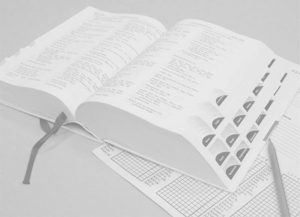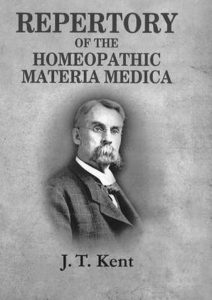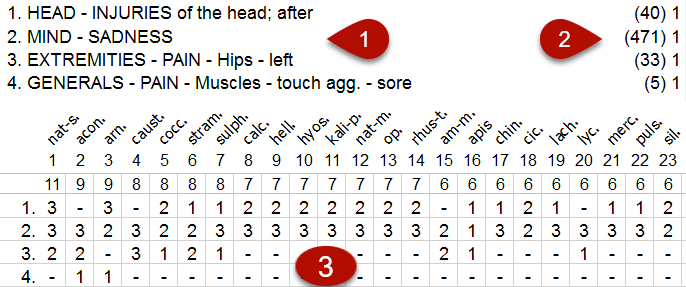Introduction
 This article examines the role of the homeopathic repertory as a fundamental tool for the classical homeopath. We will delve into the nature of the repertory, why it is an indispensable instrument within classical homeopathy, and the different types of repertories available, including their historical development. Additionally, the importance of using a physical repertory, such as ‘Essential Synthesis,’ during education is emphasized. Through a practical example, we will demonstrate how a classical homeopath navigates the vast array of symptoms and materia medica by using a repertory. Finally, we will discuss the importance of critical thinking, the value of manual interaction with the repertory, and how this contributes to an optimal learning process and greater accuracy.
This article examines the role of the homeopathic repertory as a fundamental tool for the classical homeopath. We will delve into the nature of the repertory, why it is an indispensable instrument within classical homeopathy, and the different types of repertories available, including their historical development. Additionally, the importance of using a physical repertory, such as ‘Essential Synthesis,’ during education is emphasized. Through a practical example, we will demonstrate how a classical homeopath navigates the vast array of symptoms and materia medica by using a repertory. Finally, we will discuss the importance of critical thinking, the value of manual interaction with the repertory, and how this contributes to an optimal learning process and greater accuracy.
Table of Contents
The Importance of a homeopathic repertory
In classical homeopathy, the repertory plays an essential role due to the vastness and complexity of the materia medica. This materia medica comprises an extensive collection of symptoms associated with each specific homeopathic remedy. Given the large number of remedies and their related symptoms, it is practically impossible for a homeopath to memorize or quickly retrieve all this information during or after a consultation. Without a structured approach, selecting the correct remedy based on the presented symptoms can be overwhelming and time-consuming.
The repertory offers an effective solution. As a carefully organized reference work, it systematically arranges symptoms and links them to the corresponding remedies. This enables the homeopath to methodically search for the most suitable remedy for a specific case, without having to rely solely on memory or experience.
Moreover, using a repertory contributes to a more objective and reliable method for determining the correct remedy. By working from symptoms rather than remedies, the repertory reduces the likelihood of bias and increases the chance of selecting a remedy based on a broader foundation of information.
The use of a repertory allows the homeopath to work purposefully and precisely—skills crucial in clinical practice. For these reasons, the repertory is not only a useful tool but an indispensable instrument in the daily practice of every classical homeopath.
What is a homeopathic repertory?
A homeopathic repertory is an essential instrument within classical homeopathy, playing a key role in identifying the correct homeopathic remedy based on the patient’s symptoms. It is comparable to an index in a book but with much greater complexity. Where an index links specific terms to page numbers, a repertory organizes symptoms from the complete materia medica and connects them to abbreviations of the homeopathic remedies relevant to those symptoms. While the materia medica provides a detailed description of all the symptoms associated with a particular remedy, the repertory functions as a systematic description of the remedies that fit specific symptoms. Thus, the repertory is a powerful tool for systematically and efficiently identifying the correct remedies based on the symptoms presented by the patient.
The term ‘repertory’ is derived from the Latin “repertorius,” meaning “register” or “repository.” This etymology accurately reflects the repertory’s purpose: a structured collection of knowledge specifically designed to identify the most appropriate treatments within classical homeopathy.
A core concept within the repertory is the rubric. A rubric is a structured representation of a symptom, organized from general to specific, often with multiple levels of detail. Rubrics form the building blocks of the repertory and help the homeopath to connect a specific complaint or symptom of a patient to the corresponding homeopathic remedies.
An example of a rubric is EXTREMITIES – PAIN – Hips – left. The use of capital letters is intentional to help the homeopath determine the level of a particular word. The structure of this rubric is as follows:
- EXTREMITIES – The chapter where this rubric starts is called ‘EXTREMITIES’. All symptoms regarding the extremities are located in this chapter. It is important to know in which of the 32 chapters a symptom is described.
- PAIN – The next word in the rubric is ‘PAIN,’ indicating that the issue in the extremities involves a sensation of pain.
- Hips – To specify more precisely where the pain is located, namely in the hips, the next word in the rubric is ‘Hips.’
- left – To be even more specific, this rubric refers not to both hips but only to the left hip.

The rubric in the digital version of the Essential Synthesis repertory
The process of working with a repertory is called repertorizing. This is the systematic process by which the homeopath translates symptoms from a case into rubrics in the repertory. Through this method, the homeopath can methodically determine which remedies may be suitable for treating the patient. It is important to understand that repertorizing does not provide a direct solution for which remedy should be prescribed; rather, it generates a series of suggestions that the homeopath can further investigate in the materia medica to arrive at a final choice.
The structure of a repertory follows a systematic and logical layout. It is divided into chapters that are organized according to different parts of the body and mind, beginning with general symptoms and then focusing on increasingly specific manifestations. Within each chapter, a hierarchy of symptoms is maintained, with the most general symptoms listed at the top, followed by more specific variants. This allows the homeopath to navigate the extensive information efficiently and quickly identify the relevant rubrics.
In summary, the repertory provides an organized method for selecting possible homeopathic remedies based on the patient’s symptoms. Using a repertory is therefore an essential aspect of homeopathic practice, contributing to both efficiency and accuracy in finding the most appropriate remedy.
Types of homeopathic repertories
In classical homeopathy, there are different types of repertories, each with its own specific approach and purpose. The two main categories are the utilitarian repertory and the puritan repertory. These forms serve as the foundation for many of the modern versions in use today.
The utilitarian repertory is designed with practical use and accessibility in mind. It offers an overview of symptoms and corresponding remedies in a way that allows quick identification of a suitable remedy. This type of repertory is generally less strict in the selection of symptoms and often includes a broader range, making it particularly suitable for daily use in practice. A well-known example of a utilitarian repertory is that of Kent, characterized by its practicality and ease of use.
In contrast, the puritan repertory is characterized by a strict selection of symptoms and remedies. This type of repertory adheres closely to the original descriptions of symptoms and avoids as much as possible any additions or interpretations. The puritan repertory is often seen as the more “classical” approach, emphasizing precision and fidelity to the original remedy provings.
In addition to these two main types, there are other forms of repertories, such as the clinical repertory, which focuses primarily on organizing information from a clinical perspective. There are also regional repertories, which specifically concentrate on symptoms related to certain parts of the body or functions.
Modern repertories, such as Essential Synthesis, are often a combination of various repertories, integrating both utilitarian and puritan elements. These modern versions offer the advantage of versatility and a broad source of information, making them both detailed and practically applicable in a wide range of situations.
History of the homeopathic repertory
The development of the homeopathic repertory has a rich and captivating history, closely linked to the rise of homeopathy itself. The first repertory was developed in the early 19th century by Samuel Hahnemann, the founder of homeopathy. Hahnemann soon realized that it was impractical to memorize all the symptoms and corresponding remedies from the materia medica. This insight led him to systematically organize symptoms, which eventually resulted in the creation of the first repertory.
 Throughout the 19th century, several important contributions were made to the further development of the repertory. One of the most influential contributions came from James Tyler Kent, who in 1897 published his famous Repertory of the Homeopathic Materia Medica. This work marked a significant milestone in the history of the repertory, as it introduced a comprehensive and systematic categorization of symptoms. Kent’s classification still serves as the foundation for many modern repertories today.
Throughout the 19th century, several important contributions were made to the further development of the repertory. One of the most influential contributions came from James Tyler Kent, who in 1897 published his famous Repertory of the Homeopathic Materia Medica. This work marked a significant milestone in the history of the repertory, as it introduced a comprehensive and systematic categorization of symptoms. Kent’s classification still serves as the foundation for many modern repertories today.
In addition to Kent, other prominent homeopaths such as Clemens von Bönninghausen and Adolph Lippe also developed their own repertories. Bönninghausen’s works, such as The Therapeutic Pocket-Book for Homeopathic Physicians and Boenninghausen’s Materia Medica and Repertory, as well as Lippe’s Repertory to the More Characteristic Symptoms of the Materia Medica, offered different approaches and focuses. However, they all shared the same goal: simplifying the process of finding the correct remedy based on the patient’s symptoms.
In the 20th century, the repertory continued to evolve, particularly with the advent of digital technologies. Modern software programs like Radar Opus, Vithoulkas Compass, and Hompath combine information from various classical repertories, giving homeopaths access to a more comprehensive and detailed source of knowledge than ever before. These technological advancements have not only made it easier to find rubrics, but they have also allowed for more complex analyses to be performed.
Over the years, the repertory has remained an indispensable tool, continuously adapting and improving to meet the changing demands and needs of homeopathic practice.
Critical review
Although modern software represents significant progress in terms of accessibility and ease of use, the digitization of repertories also brings new challenges. One of the most notable advantages of software is the ability to quickly integrate and add new information. This makes the repertory more dynamic and keeps it up to date with the latest developments in homeopathy.
However, this speed and flexibility come with a downside. Since much of the software is developed and managed by commercial companies, decisions might sometimes be influenced not solely by the quality of the content, but also by commercial interests. This can lead to pressure to include information that may not always be thoroughly verified, with the goal of attracting a larger user base or gaining market share. Such practices can raise questions about the reliability of some of the newer additions to the repertory.
This situation contrasts with the work of pioneers such as James Tyler Kent, who, despite the limitations of his time, strove for the highest levels of accuracy and reliability. Kent used manual processes to catalog symptoms and remedies, which inevitably led to human errors. Nevertheless, his work is still considered highly reliable because his approach was grounded in thorough research and strict verification without commercial interests.
In today’s practice, it is essential that homeopaths do not blindly rely on the latest software updates or additions to the repertory. They must remain critical and carefully weigh the information they use in their practice, paying close attention to the reliability of their sources. Ultimately, the responsibility lies with the individual homeopath to determine which information is most valuable and trustworthy for treating their patients.
Example of working with a repertory
To better illustrate what a repertory is and how it is used in practice, let’s look at an example. Imagine that during the anamnesis, various symptoms are discussed. From this larger group, specific symptoms are selected that are most relevant for finding the correct homeopathic remedy. This selection is based on PQRS, intensity, and/or causality of the symptoms. It is important to emphasize that these selected symptoms do not encompass all the patient’s symptoms, but specifically those that are most useful in classical homeopathy for finding the similimum.
The selected symptoms are as follows:
- Headache since the patient suffered a severe head injury.
- General feelings of deep sadness.
- Unexplained pain in the left hip, despite the patient’s young age.
- Muscle pain throughout the body, worsened by touch.
These symptoms are described in everyday language, but in the repertory, symptoms are presented in an organized and structured form. The homeopath’s task is to translate these symptoms into the correct rubrics in the repertory. An experienced homeopath can quickly and efficiently carry out this process. The symptoms above correspond to the following rubrics in the repertory:
- HEAD – INJURIES of the head; after
- MIND – SADNESS
- EXTREMITIES – PAIN – Hips – left
- GENERALS – PAIN – Muscles – touch agg. – sore
The complete repertorization would look as follows:
This repertorization was carried out using software, displaying the following elements:
1. The symptoms in the form of rubrics.
2. The number of remedies per rubric: in parentheses, the number of remedies per rubric is indicated, with the final number showing the weight of the rubric in the analysis.
3. A table of remedies, ranked by numerical score. This score is calculated based on various parameters and indicates which remedies are most relevant to the case. The top ten remedies in this repertorization are: Natrium Sulphuricum, Aconitum Napellus, Arnica Montana, Causticum, Cocculus Indicus, Stramonium, Sulphur, Calcarea Carbonica, Helleborus Niger, and Hyoscyamus Niger.
An experienced homeopath familiar with materia medica can quickly exclude some of these remedies as they clearly do not fit the specific case. After thoroughly studying the most relevant remedies, a process known as differential diagnosis, a final choice is made. The remedy ultimately chosen does not necessarily have to be the one that scores highest in the repertorization.
Repertory and the education of classical homeopaths
Mastering the use of a repertory is an essential part of the training to become a classical homeopath. The repertory is an indispensable tool for linking symptoms to the correct remedies, especially since it is impossible to memorize the entire materia medica. In our training program, we use the ‘Essential Synthesis’ repertory in book form, primarily because it offers several important advantages for beginner homeopaths.
 As one of the few schools, we consciously choose to use the physical book Essential Synthesis. This choice is based on several reasons:
As one of the few schools, we consciously choose to use the physical book Essential Synthesis. This choice is based on several reasons:
- Enhanced learning and understanding: Working manually with a physical book allows students to develop a deep understanding of the repertory’s structure. By seeing the rubrics in their broader context, students gain a better grasp of how symptoms are organized. This depth of understanding is harder to achieve with software, where only the search results are typically shown, without showing the intermediate steps or surrounding rubrics.
- Encouraging critical thinking and quality awareness: One of the greatest advantages of working with a paper repertory is that it forces students to think critically about the symptoms they select. Software allows quick and easy entry of symptoms and immediately provides results, which can lead to a more superficial approach to repertorizing. Manually looking up rubrics demands more effort, encouraging students to make deliberate and informed choices, resulting in a more in-depth and reliable analysis. Research supports this conclusion, such as studies referenced in Evidence Increases for Reading on Paper Instead of Screens, Learning From Books vs. Digital Learning and Reading on Paper Versus Screens: What’s the Difference? These studies indicate that reading and working from physical books lead to better comprehension and longer retention of information compared to working purely with digital tools.
- Cost savings: The purchase of the Essential Synthesis book is significantly less expensive than most software packages, which often cost over €1000. Not all students will complete their training, and the book provides a more financially secure option. If a student decides to discontinue the training, the investment in a book is less burdensome than the considerably more expensive software.
Remark: It’s worth noting that some training programs (almost) require the purchase of software. While this can be useful, it is important to think about what learning method works best for each individual. Software undoubtedly offers advantages, but the foundation of your knowledge is often stronger when you start by working manually with a paper repertory.
In our program, we ensure that students learn to use the repertory in a practical and enjoyable way. We provide numerous cases for students to work through on their own, and many find this process of “puzzling it out” quite enjoyable. In addition, we offer an extensive module where students can study the information at their own pace. We teach useful techniques and skills that help students work more quickly and efficiently with the repertory.
This approach ensures that students not only master the techniques of repertorizing, but also learn to think critically and work with precision—skills that are essential for success in homeopathic practice.




